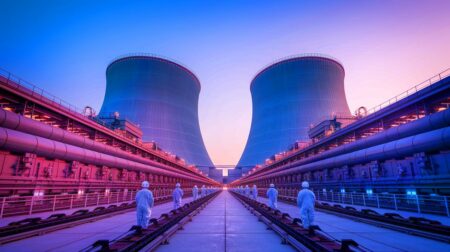India is one of the largest and most populous nations on the planet with one of the world’s fastest-growing economies. That booming economy is expected to grow at around 8% for the next decade and beyond, helping lift millions and millions of people out of poverty. A fifth of people in the world live in India, two-thirds of whom do so in the countryside. Despite marked economic progress in recent years, a quarter of a billion Indians in the vast rural hinterland continue to lack access to electricity. Yet as the country’s economy and middle-class will keep on growing, so will India’s electricity needs.
Since the turn of the new millennium, energy use in India has nearly doubled, making the country one of the world’s leading electricity producers, even as per capita consumption has remained around a third of the global average owing to persisting social and income inequalities. India generates around 1,160.1 billion units of electricity annually, as per figures from 2017 (an increase of 4.72% over 2016), trailing only behind China (6,015 terrawatt hours) and the United States (4,327 TWh).

The country currently boasts a power-generating capacity of 334.4 gigawatt, making it the fifth largest in the world. Over the past five years alone, India added another 99.21 GW of capacity, predominantly from thermal sources (91.73 GW) with the rest coming from hydropower and nuclear power (5.48 GW and 2 GW, respectively). “Multiple drivers (like industrial expansion and rising per capita income) are leading to growth in power demand; this is set to continue in the coming years,” notes the India Brand Equity Foundation (IBEF), an arm of the Indian Ministry of Commerce.
However, production levels continues to lag behind rising demands, which have outstripped domestic supply by about 7.5%. Nor has it helped matters that three-quarters of domestic energy is generated by burning fossil fuels, which has contributed to the appalling levels of air pollution in many of India’s towns and cities, blighting the lives of their residents and endangering their health.
To wean itself off fossil fuels, at least in part, India’s government has pledged to have 100 GW of new solar capacity installed by 2022 as part of its Jawaharlal Nehru National Solar Mission target. Yet, according to the ratings agency Crisil, the country is likely to come up short with a solar capacity of around 80 GW in a best-case scenario. The country’s current capacity of solar power is just sort of 22 GW, which means that it would need to nearly quadruple that capacity within the next four years to reach even that lower target.
That could leave the door open for more nuclear power. Nuclear energy, according to numerous industry experts, is a safe, clean and reliable form of abundant electricity, and it is already the fifth largest source of electricity in India after coal, gas, hydroelectricity and wind power. At its seven nuclear power plants around the country, India has 22 reactors in operation with a total installed capacity of 6,780 MW.
A drawback to nuclear power, however, is that it does not come cheap. The construction of new reactors is a costly long-term undertaking and so policymakers are often reluctant to commit themselves to the construction and maintenance of new reactors or nuclear plants. Thus, even as prosperous Western nations like Finland are forging ahead with their nuclear ambitions, developing nations like India are more hesitant to do so.

“Nuclear energy is quite mainstream. That is not the problem. The problem is that it is very expensive. Not just the cost of construction but also the cost of operating plants,” says M. V. Ramana, the Simons Chair in Disarmament, Global and Human Security at the Liu Institute for Global Issues at the University of British Columbia in Canada. Ramana is the author of The Power of Promise: Examining Nuclear Energy in India (2012) and in his current work focuses on the future of nuclear energy in the context of climate change and nuclear disarmament.
“In the United States, many old nuclear plants, which have paid off their capital costs, are shutting down because their operating costs are too expensive in comparison with renewables (which have nearly zero marginal costs) and gas (which depends on the price of gas),” Prof. Ramana tells Sustainability Times in an interview. “That is not likely to change. We know that there is no case for nuclear energy in the short to medium term,” he stresses.
Faced by high costs, many experts have been advocating for the new generation of smaller modular light-water reactors that can generate around 60 MW by using scalable versions of pressurized water reactor technology. Ramana is not one of those experts, however. “What I have argued is that the idea that a new generation of nuclear reactors will come in and solve the cost challenge, while also being safe and so on, is a false hope. I don’t think there is any point in holding on to that idea,” Ramana explains. “There may be a case for nuclear energy in the really long term — say, when we get down to 90 percent lower CO2 emissions from the electricity sector as compared to the present — but there may also be other alternatives by that time.”
That said, India’s homegrown nuclear power industry is hardly moribund. India, a vast country with excellent resources and great human capital, has largely been self-sufficient in its nuclear energy generation, from mining its modest uranium resources to manufacturing it into fuel and from designing and constructing reactors to reprocessing and managing nuclear waste. The country is also working on technologies to exploit its abundant resources of thorium as a nuclear fuel so as to reduce its dependence on the need to import uranium in large quantities.
The country’s government has said it would like to have a total of 60 GWe nuclear energy by 2032, fueled by more imported uranium, of which it has already imported some 4,500 metric tons since 2008. These targets have remained subject to debate and revision. However, according to India’s Atomic Energy Commission anywhere between 500 GWe and 700 GWe of nuclear power could be online by 2050 or 2060 in India, thereby providing half of all domestic electricity.
However, considerations of costs will remain important factors. Developing countries like India with limited financial resources, says Prof. Ramana, should “tailor their energy strategies based on cost. Given the rapid decline in the costs of solar PV and wind, investing in them is an obvious strategy, but alongside they would also need to invest in strengthening their grids so that they can deal with the intermittency of these sources.”
Western nations could and should also help finance the low-carbon transitions of nations like India, the expert argues. “[D]eveloping countries have historically much lower levels of carbon emissions and correspondingly lower levels of responsibility for climate change,” Ramana says. “So, if they have to adopt costlier sources of energy generation [like nuclear], it is only fair that they would have to be compensated,” he adds.
“Currently, I don’t see much financial flow from the developed to the developing world,” Ramana explains. “That has to change and so those interested in having developing countries transition away from coal would have to [urge] developed countries to increase their contributions to climate mitigation funds.”
Did you like it? 4.6/5 (26)








